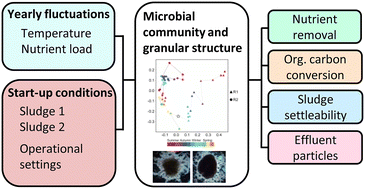Full-scale aerobic granular sludge for municipal wastewater treatment – granule formation, microbial succession, and process performance†
Abstract
Aerobic granular sludge (AGS) plants have gained growing interest and application due to their low energy demand, small footprint, and low operational costs. However, the fulfilment of strict discharge limits for nitrogen and phosphorus, vast seasonal temperature variations, and large peaks in influent flows may pose challenges to the implementation of AGS. Moreover, the knowledge about microbial community assembly and process performance under varying environmental conditions in full-scale reactors is still limited. In this study, the first implementation of the AGS process in the Nordic countries was assessed. In two full-scale AGS reactors with different seeding sludges, the start-up was associated with rapid changes in microbial community composition in both, but only successful granulation in one. As a consequence, the non-granulated reactor was eventually reseeded with biomass from the better granulated reactor. This resulted in a convergence of the microbial communities in the two reactors with the maintenance of stable sludge concentrations (6–8 g L−1) with large granules (50–80% with diameter >2 mm) and fast settling of biomass (SVI30/SVI10 of 0.9–1). Immigration from the influent wastewater was a minor factor affecting the microbial community once the granules had formed, while the seasonal variations in environmental factors were identified as important. Key guilds of AOB (Nitrosomonas), NOB (mainly Ca. Nitrotoga), PAOs (mainly Tetrasphaera), and GAOs (mainly Ca. Competibacter) varied considerably in abundance throughout the study period. After 15 months, stable organic matter, nitrogen, and phosphorus removal were attained with low effluent concentrations. During the start-up, the BOD7/N ratio, influent flow, and temperature were important factors influencing the performance of the AGS.

- This article is part of the themed collection: Recent Open Access Articles


 Please wait while we load your content...
Please wait while we load your content...